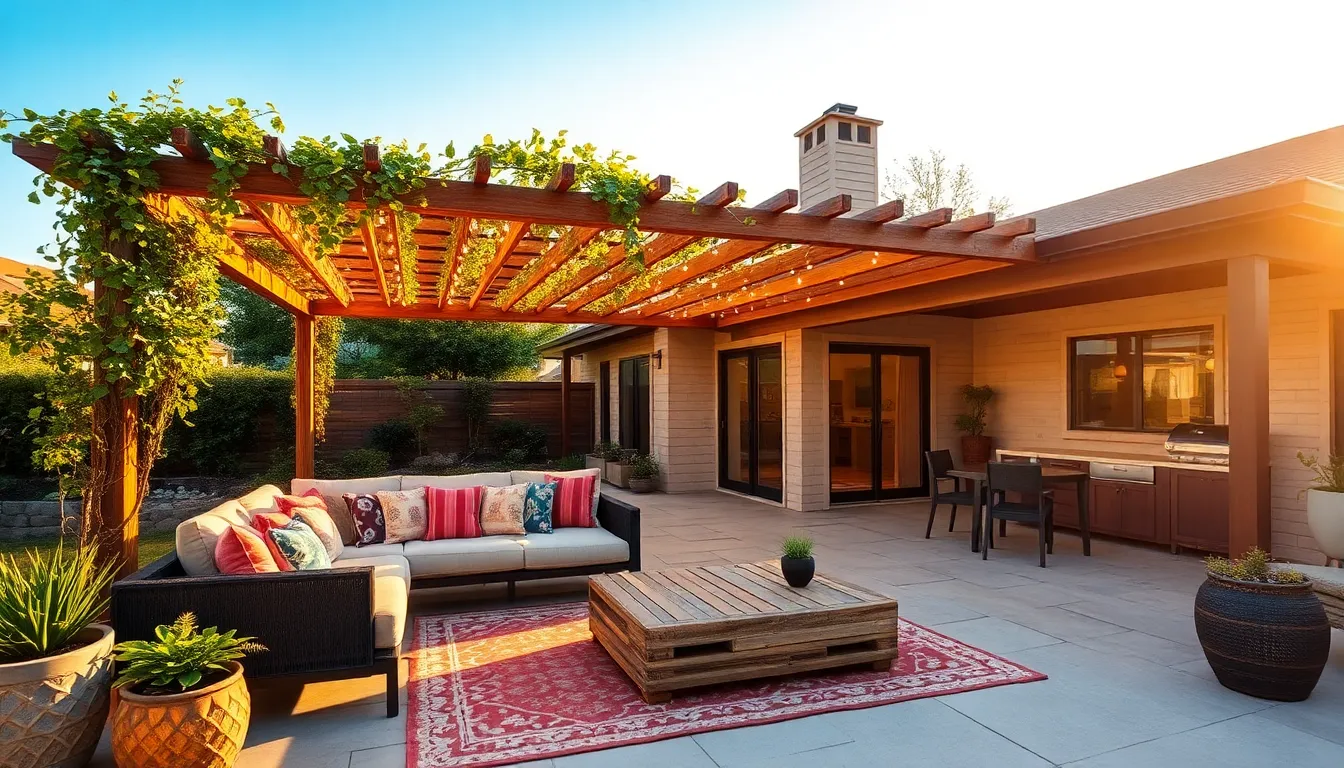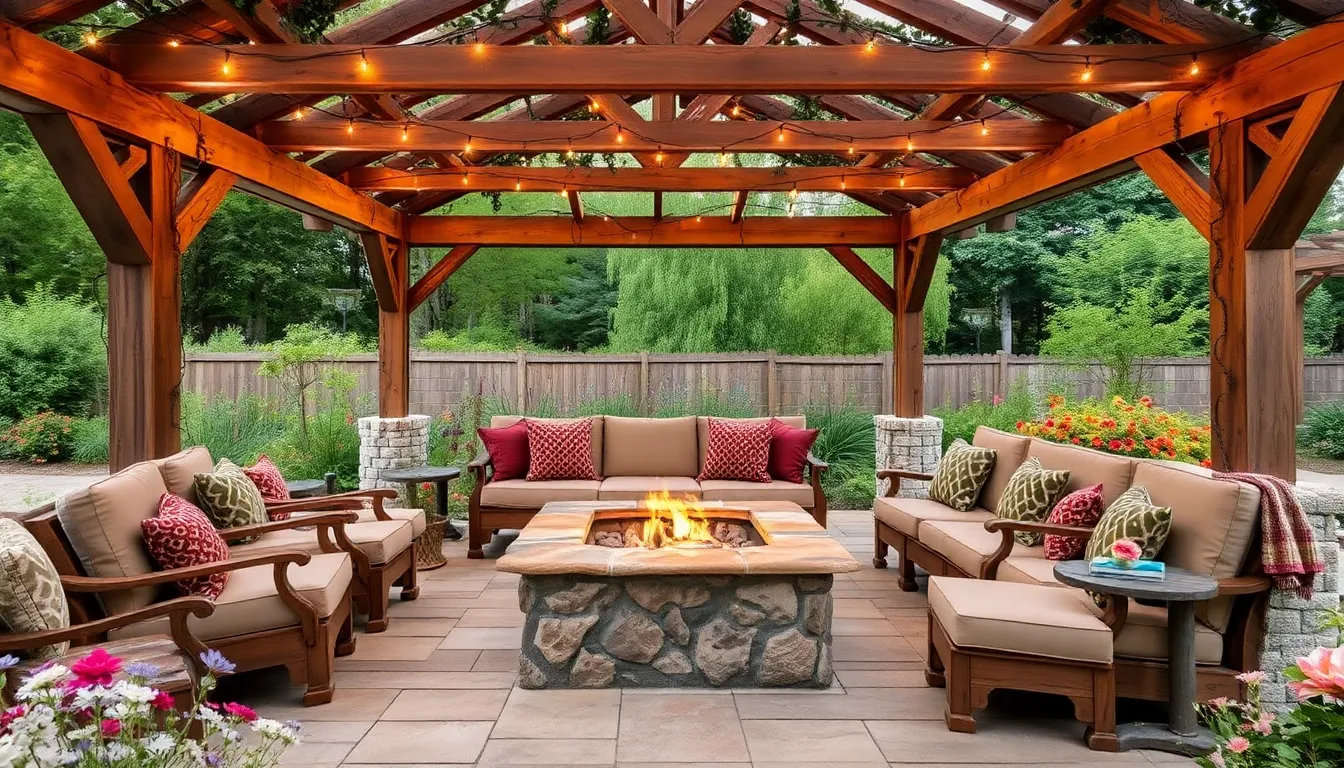Imagine stepping into your backyard oasis, where the gentle sound of rain becomes a tranquil backdrop rather than a reason to retreat indoors. For both novice gardeners and seasoned outdoor enthusiasts, creating a covered patio can transform any outdoor space into a year-round haven of relaxation and joy. This guide, “12 Covered Patio Ideas for Rainy Days,” promises to unlock the secrets to designing a space that is as practical as it is beautiful, allowing you to savor every moment outdoors, regardless of the weather.
In this collection, you’ll discover innovative solutions and inspiring designs that cater to every taste and budget. Whether you’re looking to add a touch of elegance with a pergola or seeking the cozy comfort of a canopy, these ideas will equip you with the knowledge and confidence to enhance your outdoor living experience. Prepare to embrace the delightful harmony of nature and design, and let your imagination take flight as you create a covered patio that invites both serenity and style into your home.
Install Retractable Awning Systems
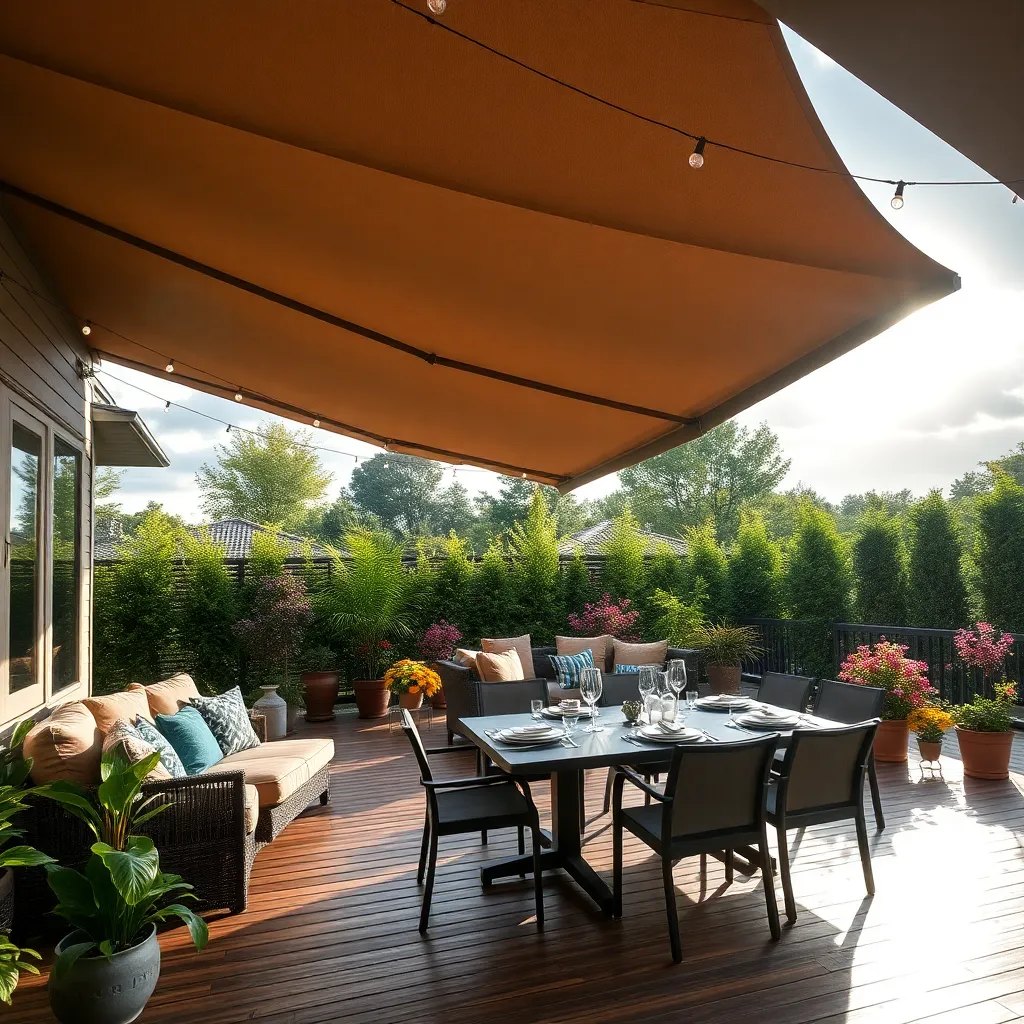
To enhance your patio for rainy days, consider installing a retractable awning system. These systems offer the flexibility to enjoy the sun when desired and provide shelter from unexpected showers with the touch of a button.
Choose materials such as acrylic fabrics or polyester coated with PVC for durability and water resistance. These materials are designed to withstand various weather conditions, ensuring your awning remains in excellent condition for years.
When planning the installation, consider the size of your patio and the typical weather patterns in your area. A standard awning extends about 10 to 12 feet, but larger patios may require custom dimensions for optimal coverage.
Beginner homeowners will find that many retractable awning kits come with user-friendly installation guides. However, for those looking for a more advanced setup, hiring a professional can ensure precise fitting and operation, maximizing the awning’s lifespan and functionality.
Remember to factor in additional design elements, such as built-in LED lighting or wind sensors, to enhance convenience and safety. These features allow you to enjoy your outdoor space more comfortably, even during inclement weather or at night.
Incorporate Waterproof Patio Curtains
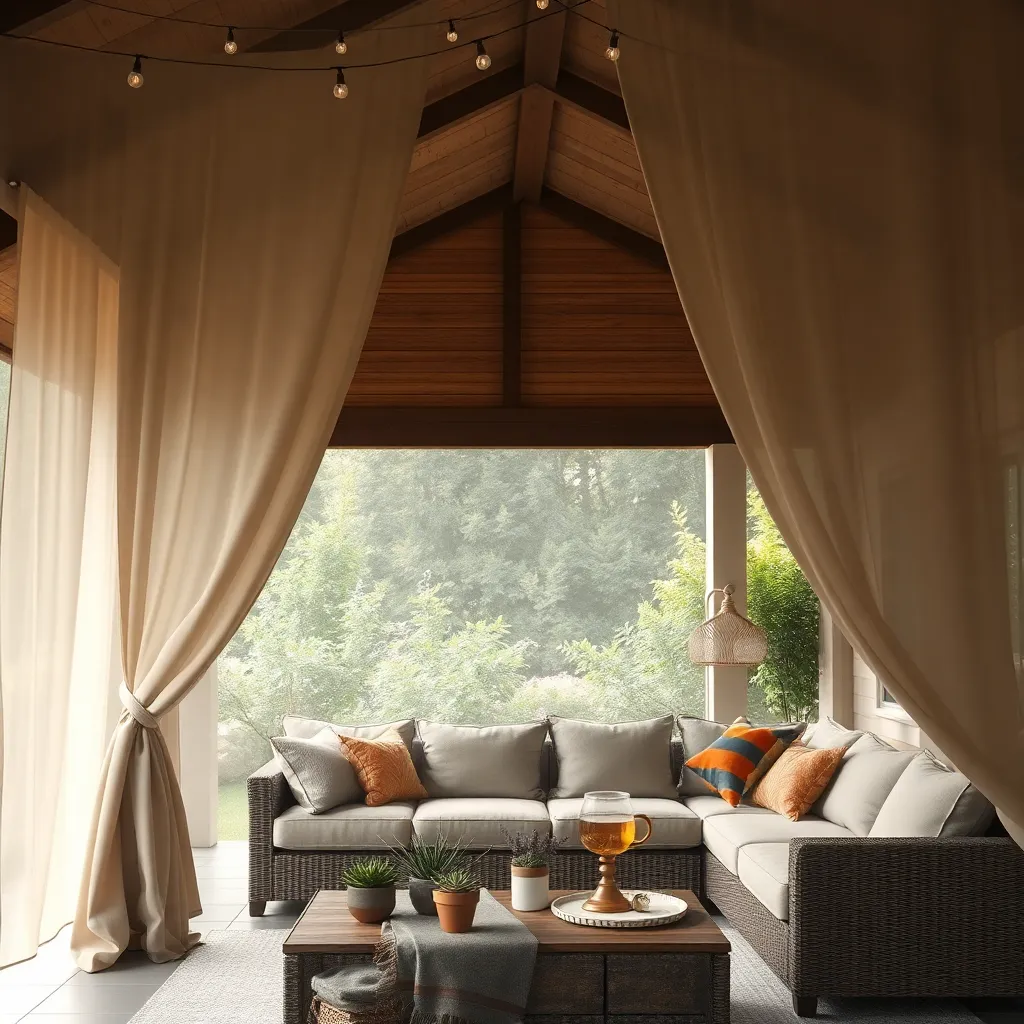
To enhance your covered patio’s functionality during rainy days, consider incorporating waterproof patio curtains. These curtains not only add a touch of elegance but also provide excellent protection against wind and rain, making them a practical choice for any homeowner.
When selecting materials, opt for durable, water-resistant fabrics such as polyester or acrylic. Both materials are known for their ability to withstand harsh weather conditions, ensuring your patio remains dry and comfortable.
Installing these curtains is straightforward, even for beginners. Use curtain rods or tracks that are specifically designed for outdoor use to ensure stability and longevity.
For a more advanced setup, consider motorized curtain systems that allow you to open and close the curtains with ease. These systems provide the convenience of adjusting your patio’s exposure to the elements with just a push of a button.
Finally, consider adding tiebacks or magnetic closures to keep the curtains secure when not in use. This not only helps maintain a neat appearance but also prevents the curtains from flapping in the wind.
Utilize Durable Outdoor Furniture
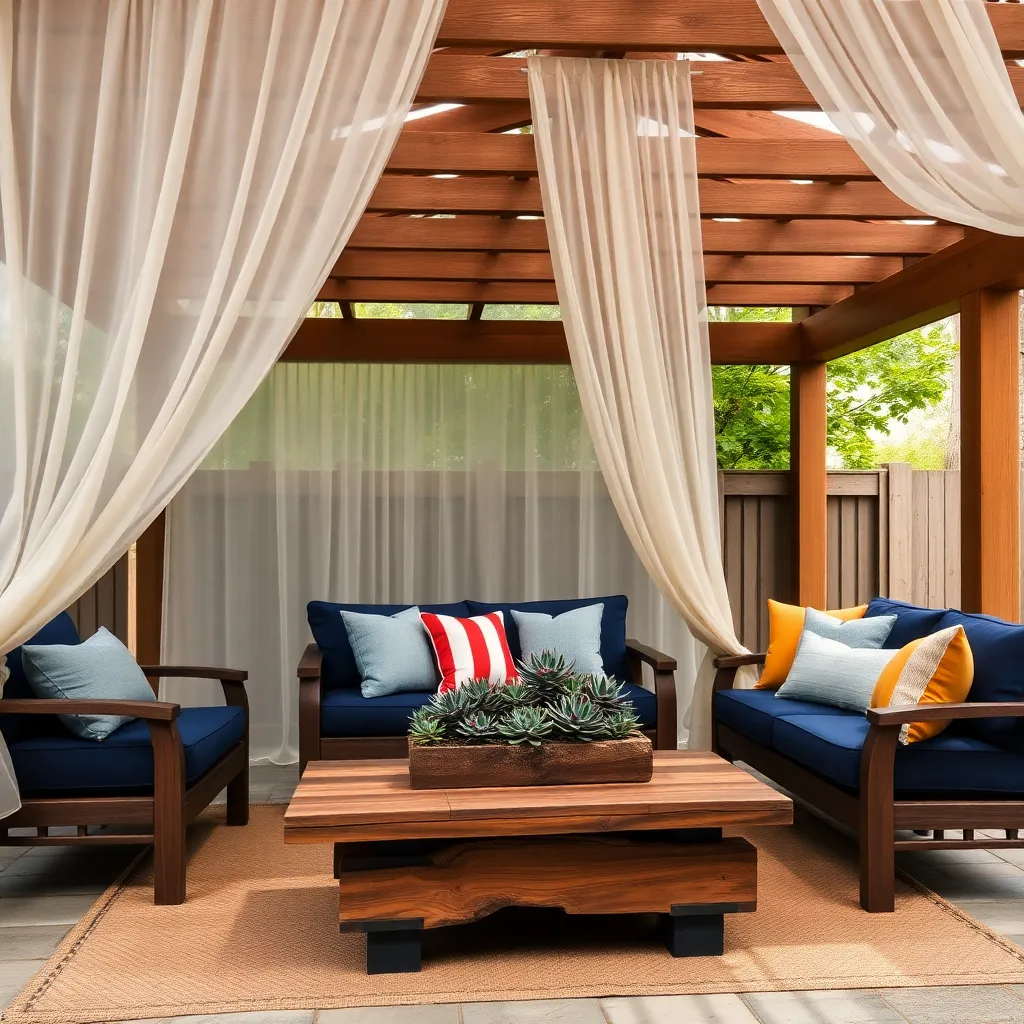
Choosing durable outdoor furniture is essential for creating a comfortable and resilient covered patio that stands up to rainy days. Prioritize furniture made from weather-resistant materials such as teak, aluminum, or powder-coated steel, which are known for their longevity and ability to withstand moisture.
Consider using quick-drying cushions and fabrics, which are specifically designed to resist mildew and mold. Look for cushions labeled as water-repellent and UV-resistant to ensure they maintain their color and integrity over time.
Incorporating furniture with built-in drainage can greatly enhance the durability of your outdoor seating. Many modern patio designs feature chairs and tables with slatted surfaces or perforations that allow water to easily pass through, preventing pooling and damage.
For a more sophisticated touch, opt for pieces that combine style with functionality, such as a teak dining table with a built-in umbrella hole. This allows you to pair your furniture with an umbrella for additional coverage, providing extra protection from rain and sun.
To maintain the longevity of your outdoor furniture, consider using protective covers when the furniture is not in use. These covers are an effective way to shield your investment from the elements and keep your patio area looking pristine all year round.
Add Weather-Resistant Cushions
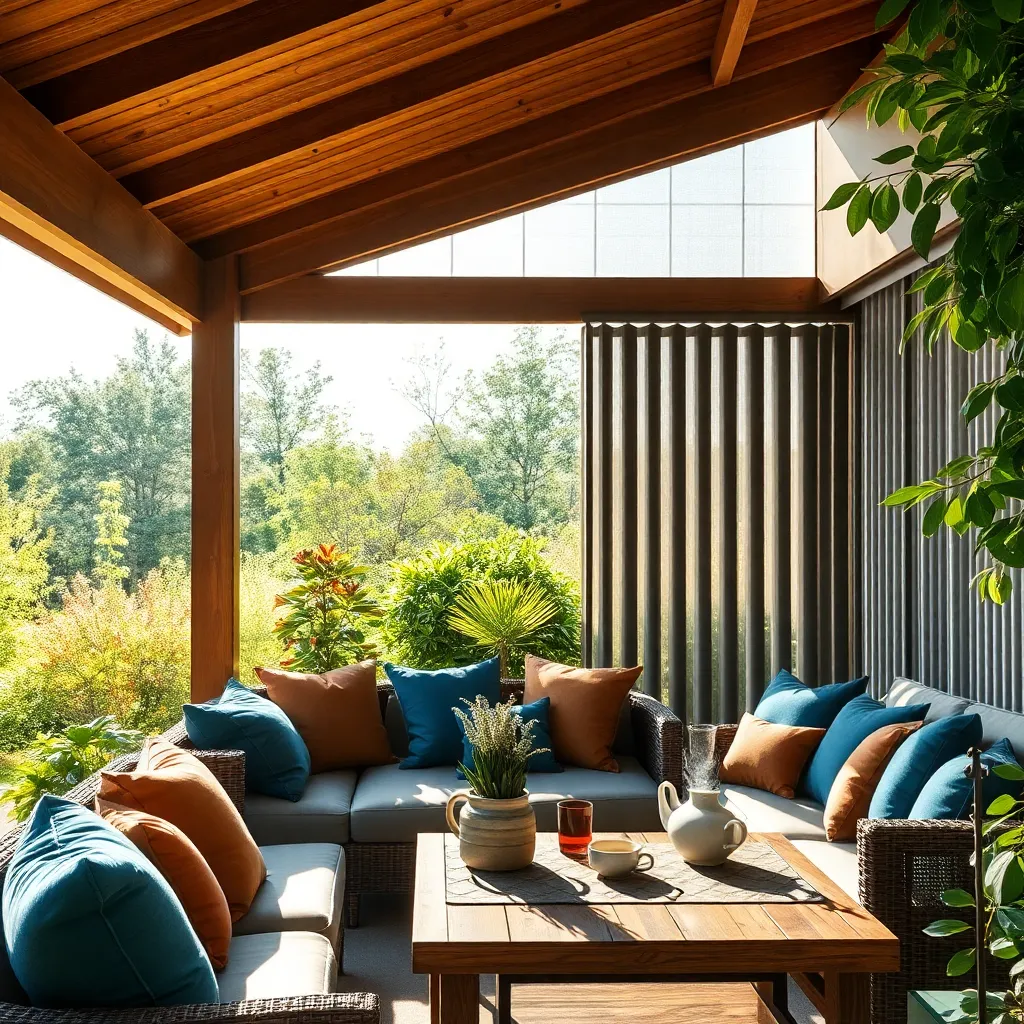
To complement your durable outdoor furniture, consider adding weather-resistant cushions for comfort and style. Choose cushions made from materials like solution-dyed acrylic or polyester, which are specifically designed to withstand the elements without fading or degrading.
Weather-resistant cushions often come with UV protection, preventing them from becoming brittle or discolored over time. Look for cushions with quick-drying foam to ensure that they remain usable shortly after a rain shower, adding convenience to your rainy-day patio setup.
Incorporating cushions with removable, washable covers can make maintenance simple and straightforward. Opt for covers with zippers or buttons for easy removal, allowing you to keep your outdoor seating fresh and inviting year-round.
For those looking to add a personal touch, consider custom-made cushions that fit your furniture perfectly and reflect your unique style. Experiment with bold patterns or vibrant colors that can brighten up your patio even on the gloomiest of days, making your outdoor space a cheerful retreat.
Opt for Sloped Roof Designs
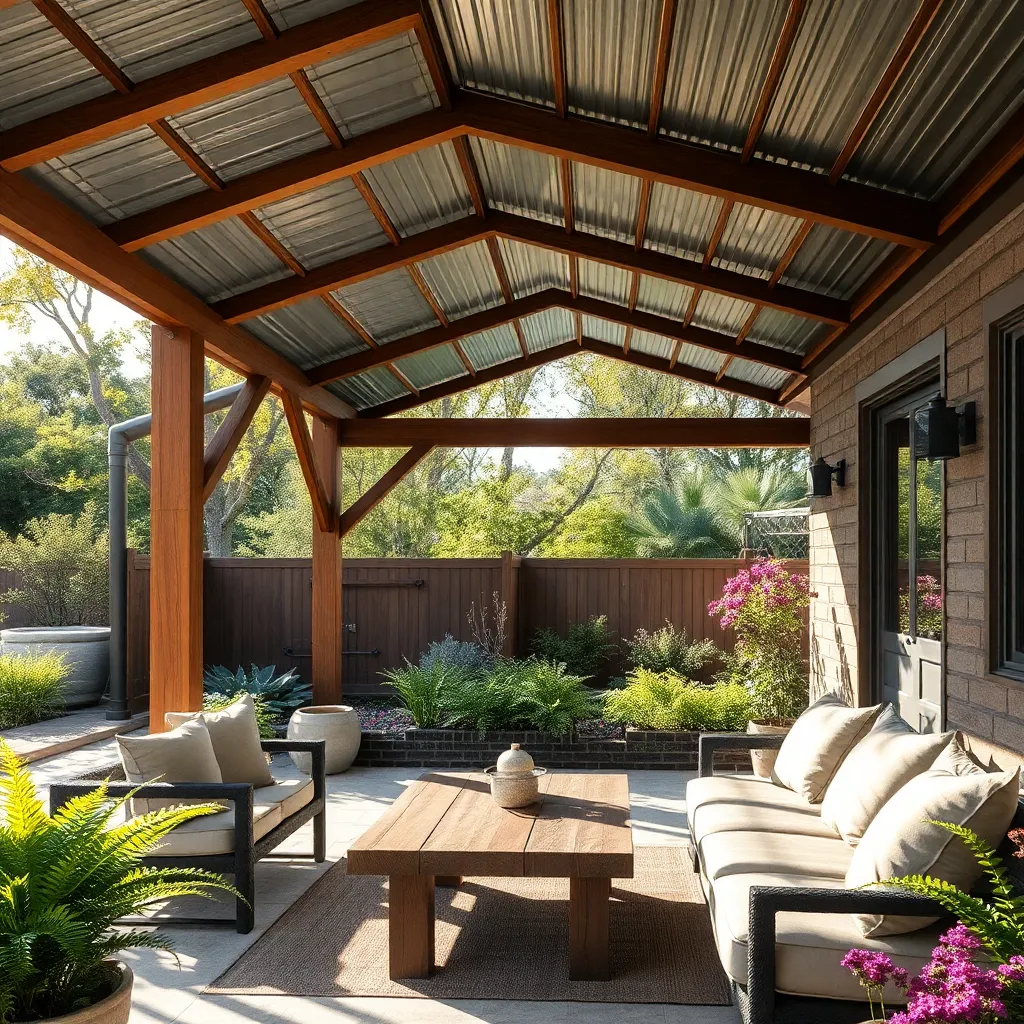
One of the best ways to ensure your patio remains dry during rainy days is to opt for sloped roof designs. This structure naturally directs water away from the sitting area, preventing puddles and reducing the risk of leaks. For a basic approach, consider using corrugated metal roofing, which is durable and allows for easy water runoff. Ensure the slope is at least 10 degrees to effectively channel water away from the structure.
Incorporating a gutter system along the edges can further enhance water management. This addition will help divert rainwater to specific areas, keeping your patio dry and free from potential water damage. For those looking to add a stylish touch, choose roofing materials like polycarbonate panels that offer both functionality and aesthetic appeal. These panels are lightweight, UV-resistant, and available in various colors to complement your outdoor decor.
Advanced builders might explore integrating a rainwater collection system with their sloped roof design. By attaching a rain barrel to the gutter system, you can efficiently collect runoff for garden use, promoting sustainability. When constructing the shelter frame, using treated wood or aluminum can ensure longevity and resistance against moisture. These materials are not only sturdy but also require minimal maintenance over time, making them ideal for outdoor settings.
Lastly, adding decorative elements like exposed beams can enhance the visual appeal of your sloped roof shelter. Choose weather-resistant wood such as cedar or redwood for beams that can withstand the elements. For added ambiance, consider installing outdoor string lights along the rafters to create a cozy atmosphere. This combination of functionality and style will make your patio a welcoming retreat, rain or shine.
Create Drainage-Friendly Flooring
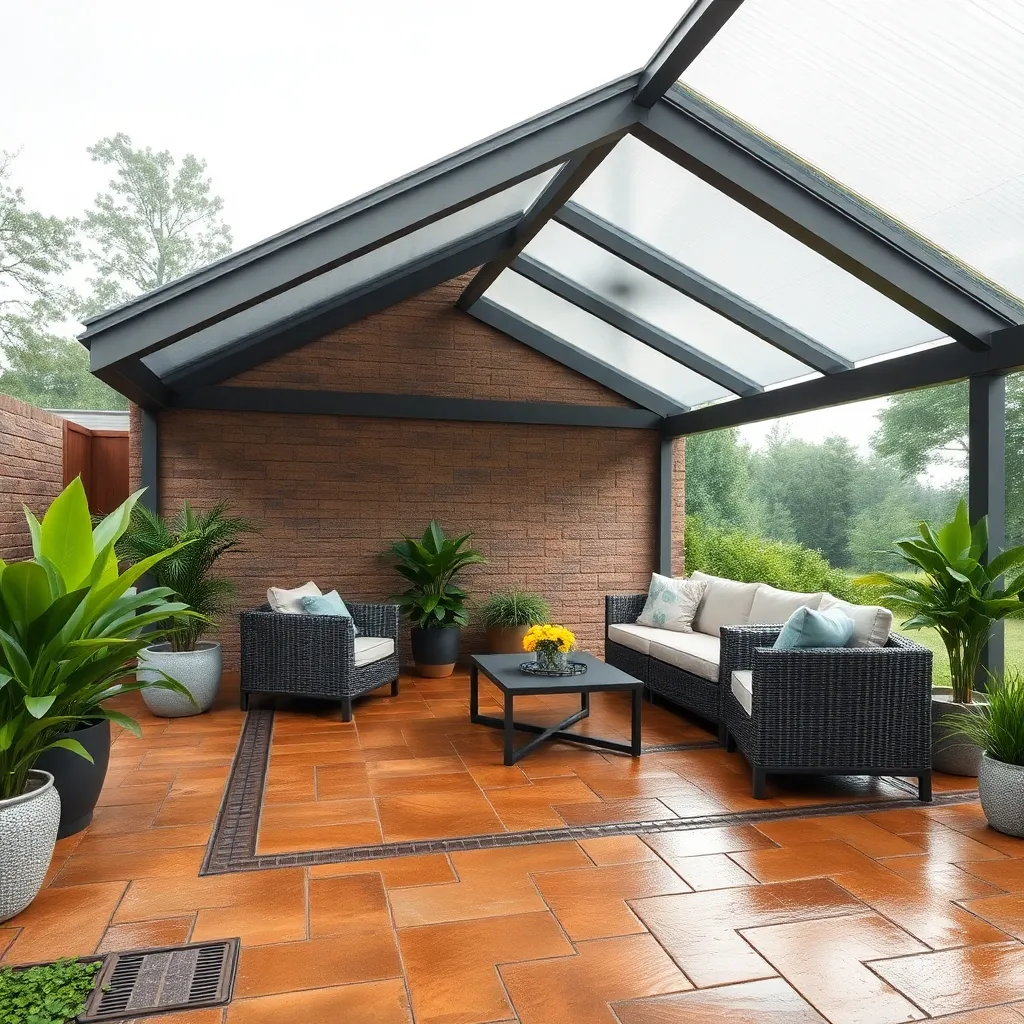
To ensure your covered patio is ready for rainy days, focus on creating a drainage-friendly flooring system. Start by selecting materials that naturally allow water to pass through, such as permeable pavers or gravel. These materials not only prevent water pooling but also help maintain a dry, usable space under your shelter.
Consider the slope of your patio floor to aid in effective water drainage. A slight gradient of about 1% (or 1/8 inch per foot) is recommended to direct water away from your home and towards a drainage area. This simple design technique can significantly reduce water-related issues, keeping your patio dry and functional.
For those looking to enhance their patio’s durability, installing a French drain beneath the flooring can be a game-changer. This involves creating a trench filled with gravel and a perforated pipe that redirects water away from your patio. French drains are particularly useful in areas with heavy rainfall, ensuring water doesn’t compromise your outdoor space.
Additionally, using interlocking patio tiles made from materials like rubber or wood composite can offer a quick and effective drainage solution. These tiles are designed with built-in gaps that promote water flow and are easy to install, making them ideal for both DIY enthusiasts and experienced gardeners. By choosing the right materials and techniques, you can create a patio floor that stands up to rain and enhances your outdoor living experience.
Select Rainproof Ceiling Fans

When it comes to enhancing a covered patio for rainy days, selecting a rainproof ceiling fan can make a world of difference. Not only do these fans provide a refreshing breeze, but they also help circulate air to reduce dampness and humidity.
To ensure longevity, choose fans specifically rated for outdoor use, often labeled as ‘damp’ or ‘wet’ rated. Wet-rated fans are ideal for more exposed areas, as they can withstand direct rain contact without damage.
Consider materials that resist the elements, such as blades made from ABS plastic or specially treated wood. These materials are not only durable but also come in various styles to complement your patio’s aesthetic.
For a more advanced setup, look for models with integrated lighting or smart controls. Smart fans can be adjusted using a remote or smartphone app, allowing you to easily tailor the airflow and lighting to your needs.
Integrate Built-In Heat Lamps

Integrating built-in heat lamps into your covered patio can transform a chilly area into a warm, welcoming space. Heat lamps are an excellent choice for creating year-round usability, particularly in regions where temperatures drop significantly.
When selecting heat lamps, it’s important to choose models specifically designed for outdoor use. Look for weather-resistant features like sealed electrical components and durable materials such as stainless steel or powder-coated aluminum.
Placement is crucial for maximizing the warmth from your heat lamps. Install lamps at a height of 8 to 10 feet for optimal heat distribution, making sure they are evenly spaced to avoid cold spots.
For those ready to take it up a notch, consider heat lamps with adjustable settings. These models allow you to control the temperature, ensuring the perfect ambiance regardless of the outdoor conditions.
Choose Water-Repellent Umbrellas
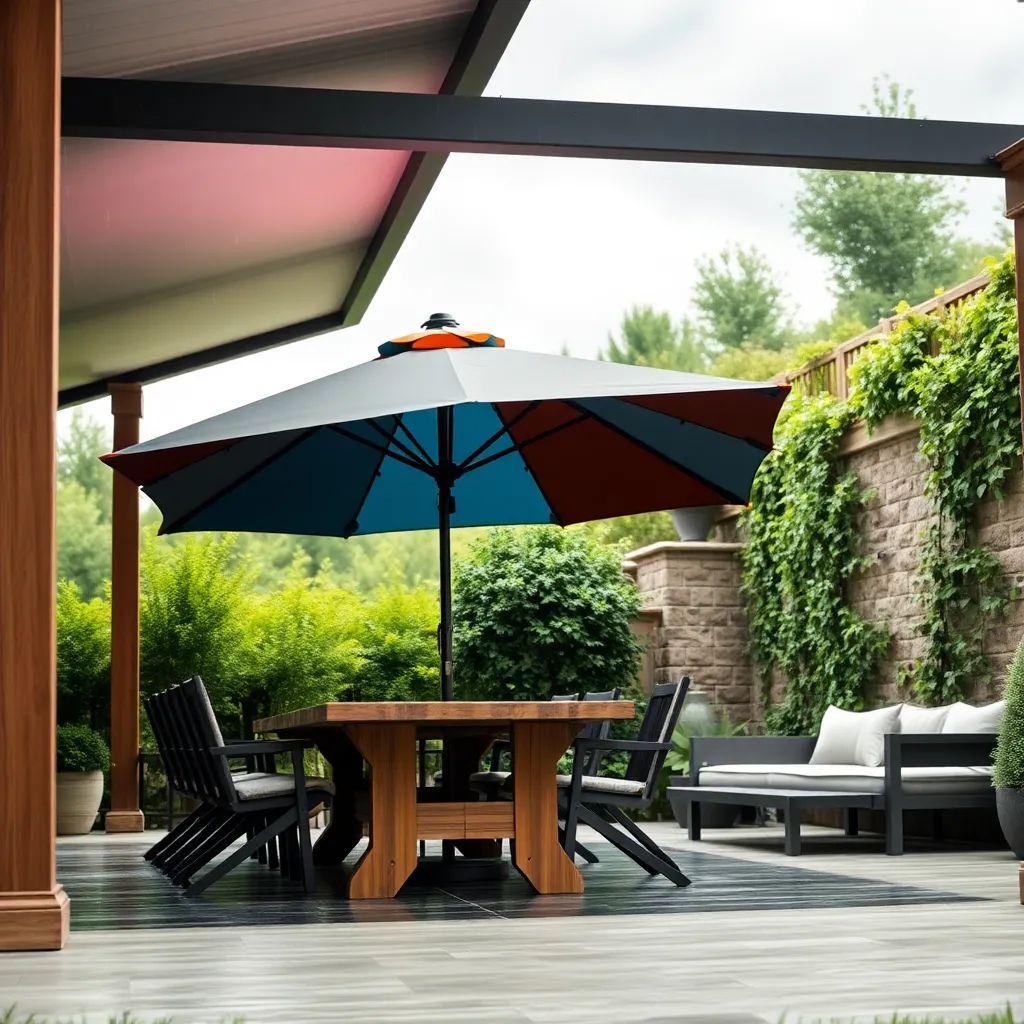
Choosing water-repellent umbrellas is a fantastic way to enjoy a rainy day on your patio without getting drenched. These umbrellas are designed with specialized fabrics that repel water, keeping you dry beneath their wide canopies.
For beginners, it’s important to select umbrellas made from durable materials like polyester or acrylic, which offer excellent water resistance. Additionally, look for models with rust-proof poles and bases, ensuring they withstand wet weather conditions over time.
Advanced gardeners can experiment with adjustable tilt mechanisms, allowing the umbrella to block rain from any angle. Consider investing in a cantilever umbrella for greater coverage and flexibility in positioning, perfect for larger spaces or multiple seating areas.
Maintaining your water-repellent umbrella is straightforward yet essential for longevity. Regularly clean the fabric with mild soap and water, and store the umbrella in a dry place during extreme weather to prevent mold and mildew formation.
Apply Waterproof Paint Finishes
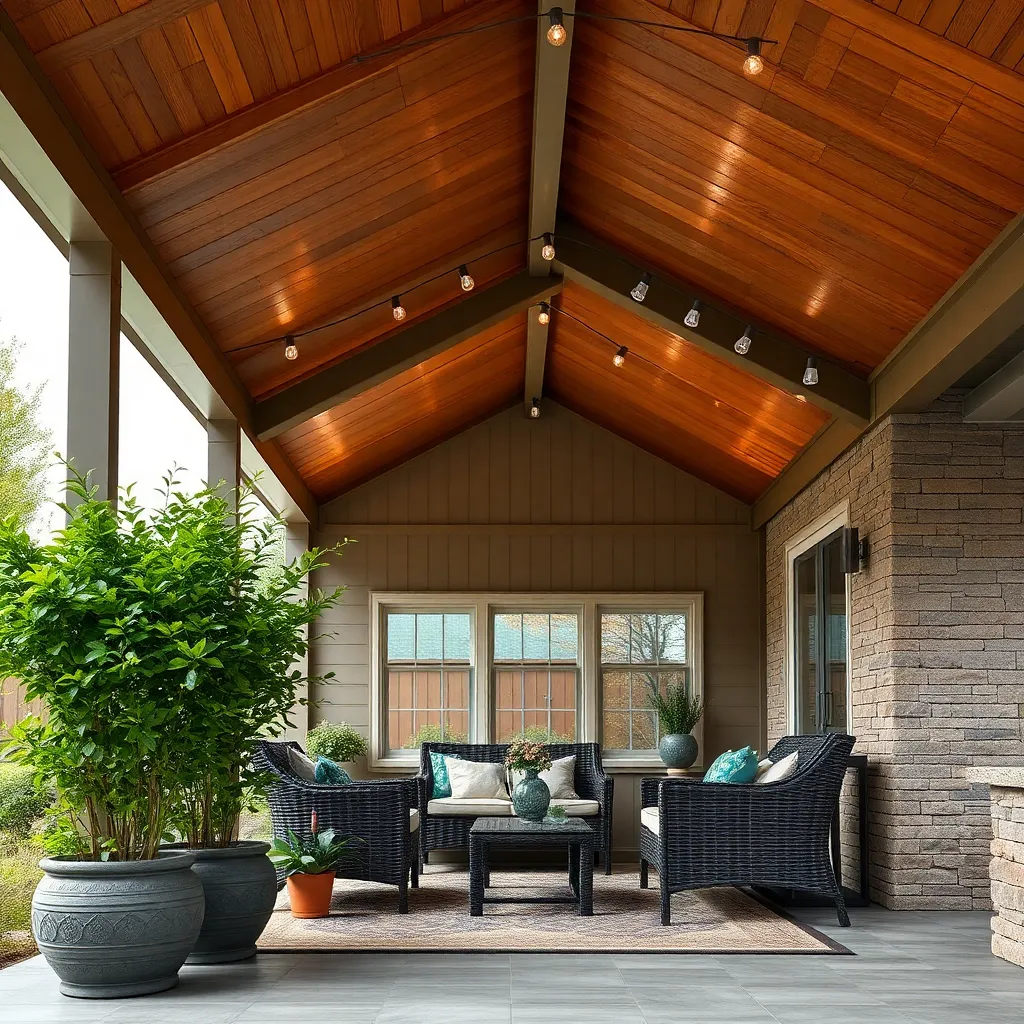
Applying waterproof paint finishes to your patio can significantly enhance its durability and appearance during rainy days. Begin by selecting a high-quality waterproof paint specifically designed for outdoor use, ensuring it has excellent adhesion properties to withstand various weather conditions.
It’s crucial to properly prepare the surface before painting to achieve the best results. Clean the patio thoroughly, removing any dirt, mold, or old paint, and ensure it’s completely dry before applying the new paint.
When selecting a paint color, consider lighter shades which can help reflect sunlight and keep the area cooler during sunny days. For a more advanced touch, you can use a paint sprayer for an even, professional finish, especially on larger surfaces.
For homeowners seeking extra protection, consider applying a clear waterproof sealant over the paint. This additional layer can provide enhanced protection against moisture and prolong the life of the paint job, making it especially useful in areas with heavy rainfall.
Set Up a Gazebo Structure
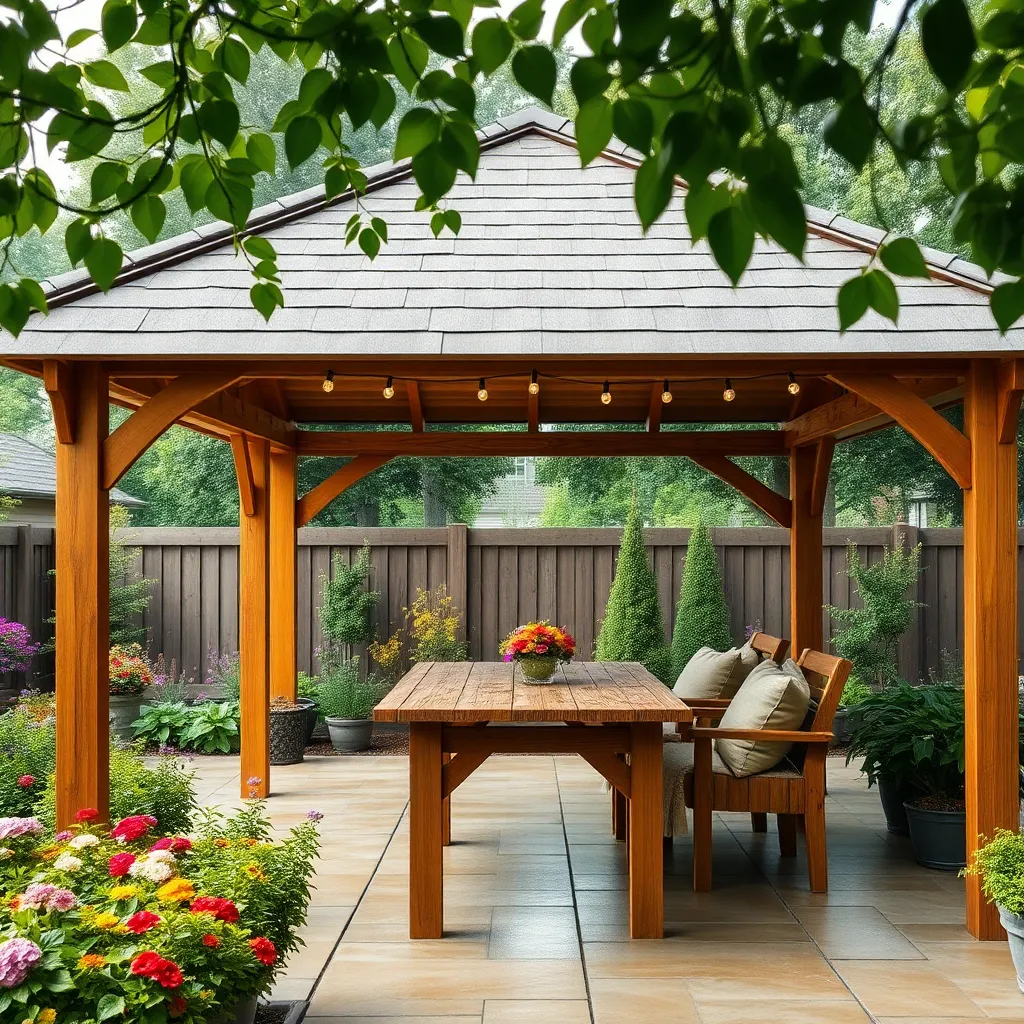
Setting up a gazebo structure can transform your patio into a cozy retreat that withstands rainy days. Begin by selecting a suitable location, ideally a flat area that provides adequate drainage to prevent water pooling.
For materials, consider using weather-resistant options like cedar or vinyl, which offer both durability and aesthetic appeal. Ensure that the gazebo’s size complements your patio space; a common dimension is 10×10 feet, which offers ample room for seating without overwhelming the area.
Assembly can be straightforward with pre-fabricated kits, which often come with easy-to-follow instructions and all necessary hardware. For a more customized approach, hiring a professional to construct a bespoke design can provide a personalized touch, especially if you have unique requirements or an irregular patio layout.
Enhance your gazebo with features like a sturdy roof to keep rain at bay and curtains or screens to add privacy and additional weather protection. Consider incorporating gutter systems to effectively manage rainwater, preventing damage and maintaining the structure’s integrity over time.
Include Transparent Roof Panels
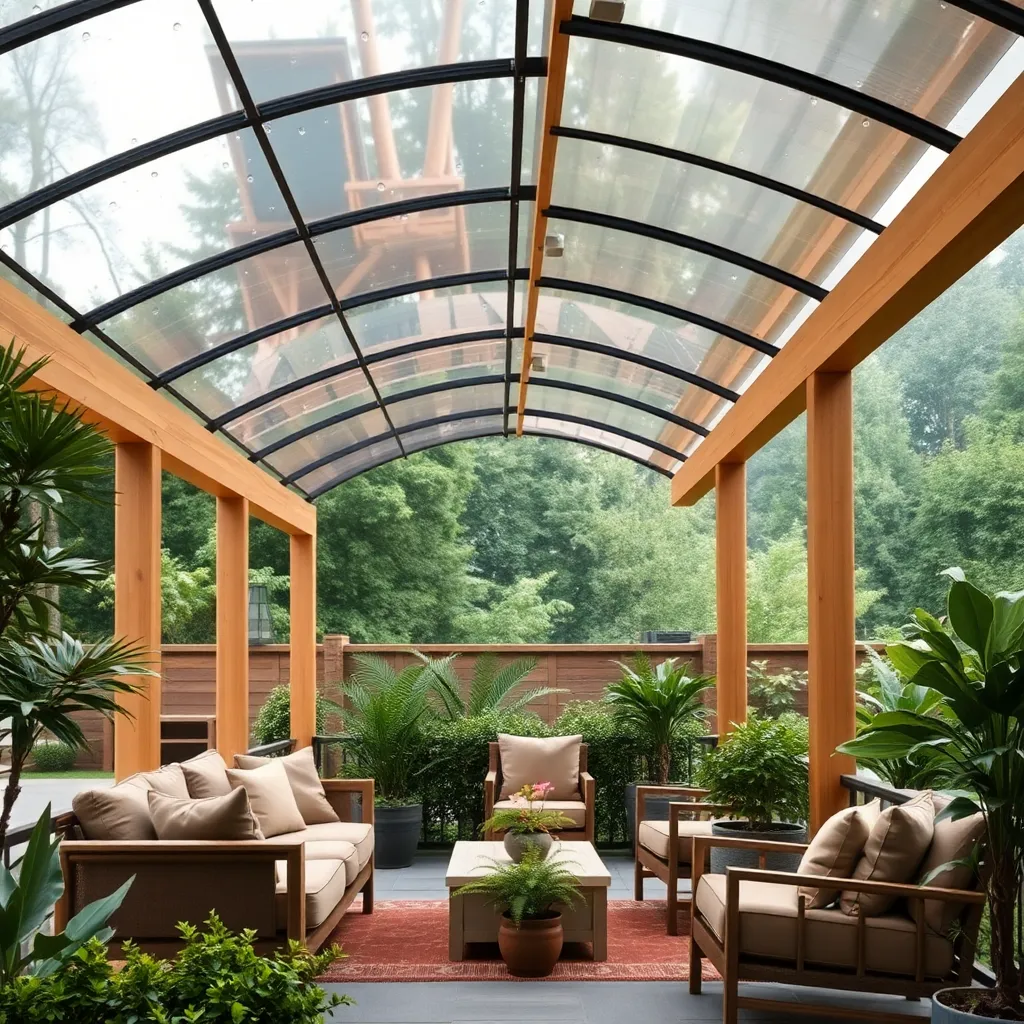
Including transparent roof panels in your patio design can dramatically enhance your outdoor space. These panels allow natural light to flood the area while providing shelter from rain, making your patio usable in various weather conditions.
When choosing materials, consider options like polycarbonate or acrylic, which are both durable and provide UV protection. Polycarbonate panels are particularly popular due to their strength and ability to withstand harsh weather, ensuring long-term performance.
For installation, ensure that the panels are securely fastened to prevent leaks and withstand wind. Use a slight slope in the design to facilitate water runoff, which helps maintain the panels’ clarity and longevity.
Beginners can start with a simple rectangular frame and gradually progress to more complex shapes. Advanced DIYers might explore integrating solar panels alongside transparent sections, combining aesthetics with energy efficiency.
Conclusion: Creating Beautiful Outdoor Spaces
In exploring the ’12 Covered Patio Ideas for Rainy Days,’ we’ve uncovered foundational concepts that can shelter and nurture your relationship through life’s inevitable storms. From creating safe spaces for open communication and fostering shared activities that bring joy, to cultivating resilience through adaptability and embracing moments of quiet reflection together, each idea serves as a sturdy pillar to support your partnership. These insights remind us that a strong relationship, much like a well-designed patio, thrives when built with intention and care.
Now is the perfect time to take action. Choose one idea that resonates with you and your partner, and make a plan to incorporate it into your relationship this week. Whether it’s scheduling a cozy date under your favorite blanket or having a heartfelt conversation, let this be the start of a new chapter in your relationship journey.
Remember to save or bookmark this article for future inspiration and guidance. As you continue to cultivate these practices, envision a future where your relationship stands steadfast, enriched by the warmth and connection you’ve intentionally crafted. Your commitment today paves the way for a flourishing partnership tomorrow.



